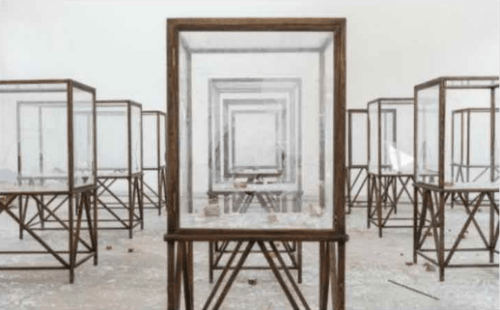
As with all trauma, revolution defies the ability of language to describe it. Jacques Lacan, the French psychoanalyst and philosopher, actually defined trauma as that which cannot be articulated by language. And so it is with great difficulty that we attempt to write about Kader Attia’s Beginning of the World, a site-specific installation at the Galleria Continua that is the very revolution that it tries to portray.
Dozens of glass cages fill the cavernous factory-turned-gallery space, cracked and punctured by rocks. Shattered glass lies strewn over the concrete floor. The remains of crumbled buildings are scattered listlessly around the room. Broken neon signs blink, indifferent to the destruction.
Beginning of the World is about revolutions. It is about what happens when tyrants are toppled, when the masses rise up in righteous indignation against their oppressors and – knowing not what else to do – tear down the very walls of the establishment in a destructive, purifying rage that sweeps away all before it. It is about the deplorable failure of modernity to keep its promise to create a society in which all are provided for. It’s also about a new beginning, and how all beginnings must necessarily also signify the end of what came before.
And yet, there are always remnants. In the exhibition notes, Attia mentions being inspired by the Arab Spring. Looking around us, what we notice is that the destruction here has been caused by the humble means of the working class: sticks and stones rather than tanks and bombs, just as with all proletarian uprisings.
No words or images can come close to capturing what it is like to stand in the midst of Attia’s vision. The exhibition is itself a revolution, enacting the very trauma it seeks to portray.
